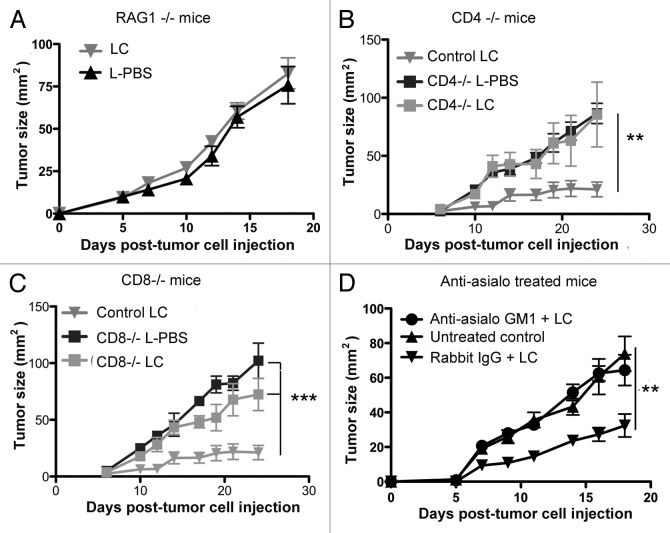Figure 2. Effects of LC treatment in T cell and NK cell deficient mice. (A) MCA205 tumors were established in Rag1−/− mice (n = 5 per group) and half of the mice were treated with LC. Tumor growth was measured and growth curves (mean tumor size (mm2), ± SEM) were generated. Tumor growth was not significantly different (p = 0.95) in LC-treated Rag1−/− mice compared with L-PBS treated Rag1−/− mice. In (B), Cd4−/− mice with MCA205 tumors were treated with LC or L-PBS and tumor growth rates were compared with wild type mice treated similarly. The tumor growth rates in Cd4−/− mice treated with LC or L-PBS were significantly different (**p < 0.01) from wild type mice treated with LC. In (C), tumor growth rates in wild type mice treated with LC were significantly decreased as compared with Cd8−/− mice treated with LC or L-PBS (***p < 0.001). In (D) MCA205 tumor-bearing mice (n = 5/group) were treated weekly with either: 1) LC plus anti-asialo GM1 antibody administered 24h prior to the LC treatment once weekly, 2) LC and an irrelevant control antibody weekly, with the control antibody administered 24 h prior to the LC treatment, or 3) received no treatment. Tumor growth rates in mice treated with asialo-GM1 antibody and LC were not significantly different from untreated control mice, whereas mice treated with irrelevant rabbit IgG and LC had significantly reduced tumor growth rates compared with control and anti-asialo GM1 treated mice (**p < 0.01). Similar results were obtained in one additional experiment. Tumor growth rates were compared using repeated-measures ANOVA followed by Bonferroni post-test.

An official website of the United States government
Here's how you know
Official websites use .gov
A
.gov website belongs to an official
government organization in the United States.
Secure .gov websites use HTTPS
A lock (
) or https:// means you've safely
connected to the .gov website. Share sensitive
information only on official, secure websites.
